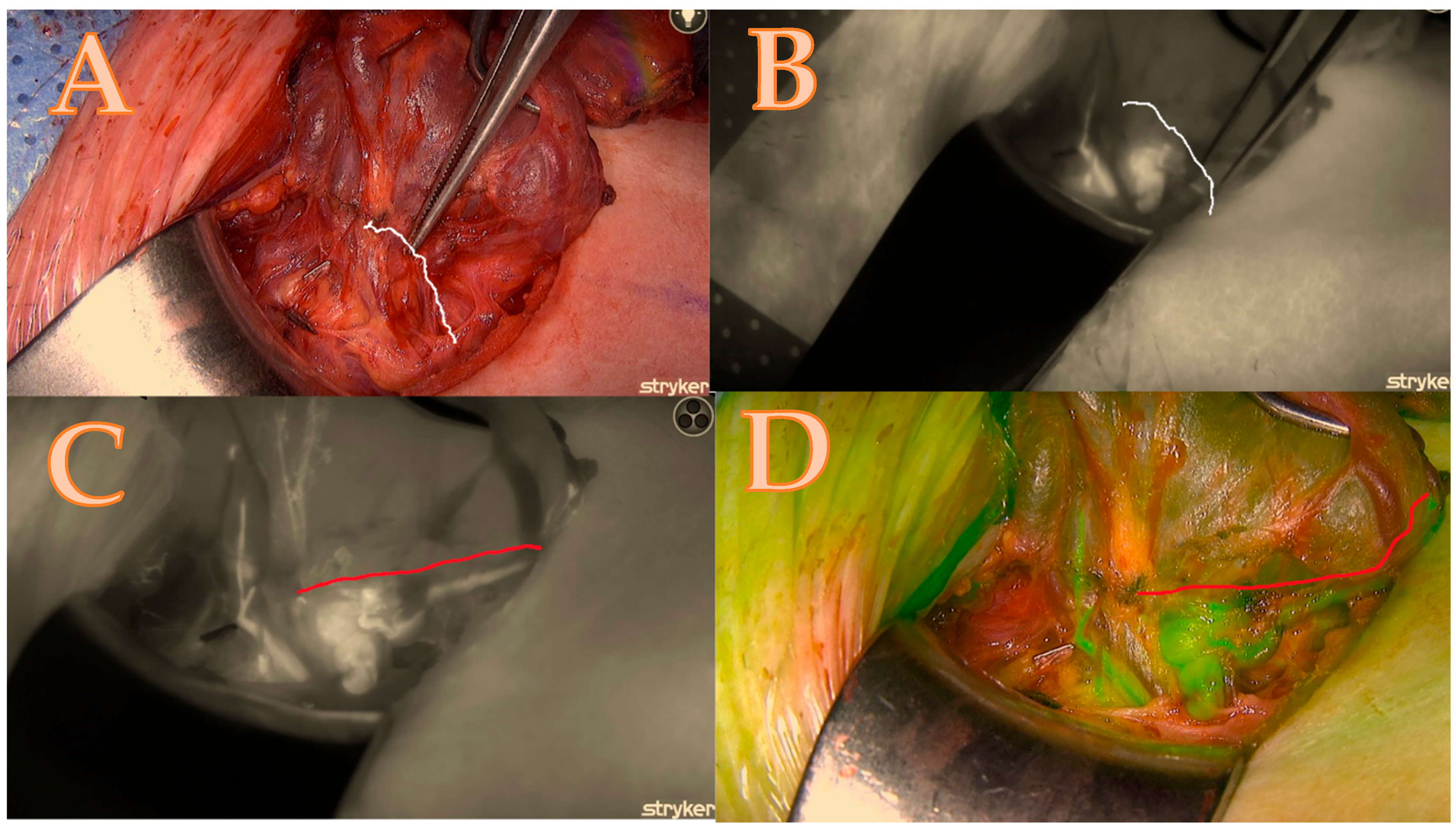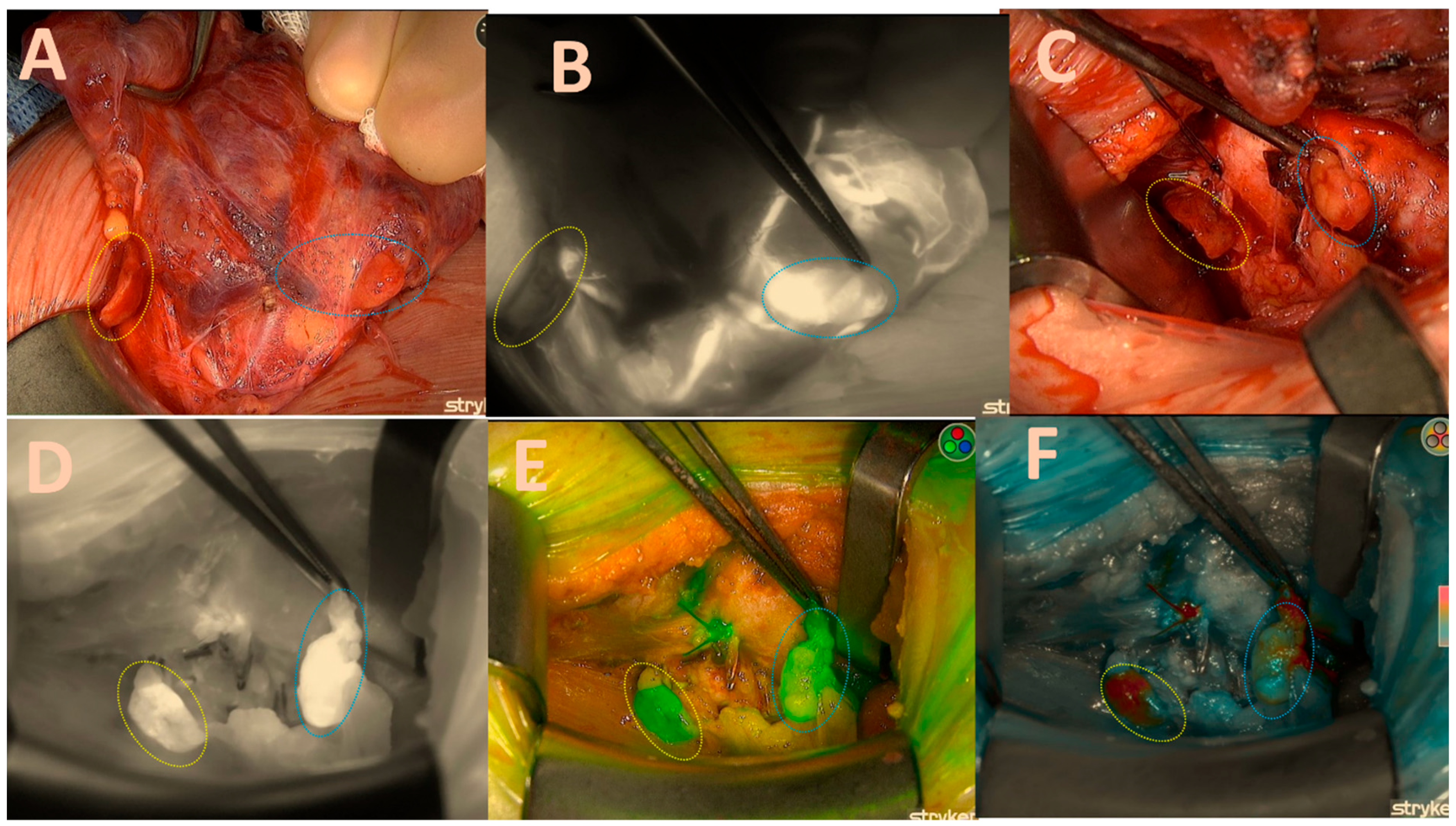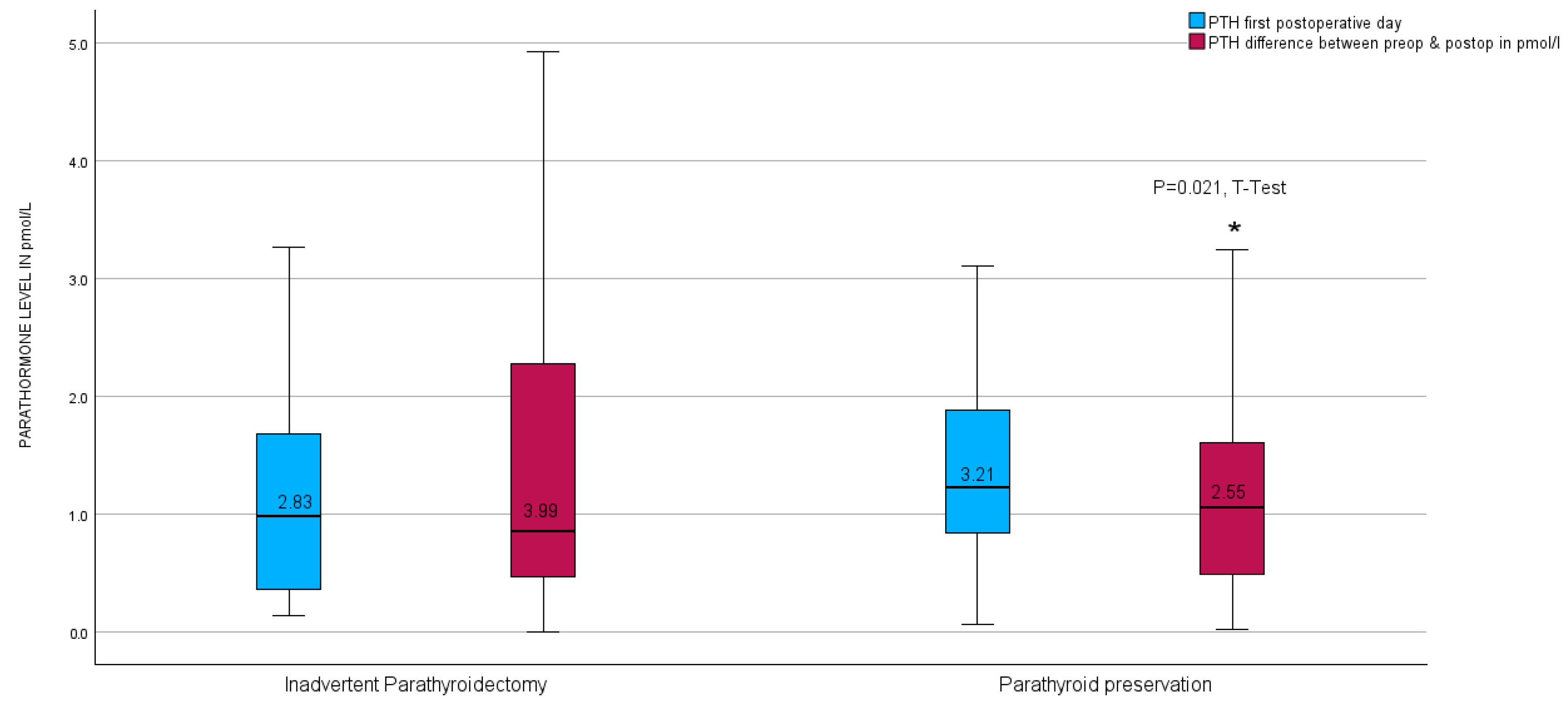Optimizing Parathyroid Preservation in Thyroidectomy: The Burjeel Protocol Utilizing Intraoperative Indocyanine Green Near-Infrared Fluorescence Imaging †
Abstract
1. Introduction
2. Materials and Methods
2.1. Burjeel ICG-NiR Autofluorescence Protocol
- ▪
- Green: 2 points for strong fluorescence;
- ▪
- Black/White: 2 points for clear visualization;
- ▪
- Red/Orange/Blue/Grey: 2 points for visible identification;
- ▪
- Vitality confirmation by the surgeon: 1 point.
- Green mode: 2 points;
- Black/White mode: 1 point;
- Red/Orange/Blue/Grey mode: 2 points;
- Surgeon’s assessment (vitality confirmation): 1 point;
- Total score: 6 points out of a possible 7.
- The total score for each gland was tallied, and the aggregate score for the entire set of glands was calculated. For example, in a case where both right upper and right lower glands scored 6 and 5 points, respectively, the total score for both glands would be 11 out of a possible 14 points.
- The score ratio is calculated by dividing the total score by the maximum possible score and converting it into a percentage. In this case, 11/14 = 78.5%. This methodology allows for a comprehensive and standardized assessment of parathyroid gland viability, combining clinical assessment with advanced fluorescence imaging (see Table 1 and Figure 1, Figure 2, Figure 3 and Figure 4).
2.2. Surgical Technique
2.3. Postoperative Parathormone Monitoring
2.4. Statistical Analysis
3. Results
4. Discussion
Author Contributions
Funding
Institutional Review Board Statement
Informed Consent Statement
Data Availability Statement
Acknowledgments
Conflicts of Interest
Abbreviations
| ICG | Indocyanine Green |
| NiR | Near-Infrared |
| PTH | Parathyroid Hormone |
| TPO | Thyroid Peroxidase |
| Vit D3 | Vitamin D3 |
| ASA | American Society of Anesthesiologists |
| EMG | Electromyogram |
| SLN | Superior Laryngeal Nerve |
| RLN | Recurrent Laryngeal Nerve |
| SPSS | Statistical Package for the Social Sciences |
| CT | Computed Tomography |
| BMI | Body Mass Index |
References
- Ossola, P.; Borasi, A.; Barberis, A.; Marola, S.; Ghiglione, F.; Pentassuglia, G.; Puligheddu, B.; Brustio, P.R.; Messuti, I.; Bononi, M.; et al. Early parathyroid hormone (PTH) level as a predictor of post-surgical hypoparathyroidism. Acta Chir. Belg. 2024, 4, 1–11. [Google Scholar] [CrossRef] [PubMed]
- Naushad, A.; Sattar, S.; Salik, M.; Wajid, M.; Khalid, F.; Hussain, A.; Siddiqui, M.I.U.; Masood, M.Q. Frequency and Risk Factors of Permanent Hypoparathyroidism After Total Thyroidectomy: An Experience at a Tertiary Care Hospital in Pakistan. Ear Nose Throat J. 2023, 26, 1455613231173455. [Google Scholar] [CrossRef] [PubMed]
- Neagoe, O.C.; Ionică, M. Improvement in Central Neck Dissection Quality in Thyroid Cancer by Use of Tissue Autofluorescence. Cancers 2024, 16, 258. [Google Scholar] [CrossRef] [PubMed]
- Doulaptsi, M.; Ierodiakonou, D.; Prokopakis, E.; Stanitsa, N.; Rogdakis, A.; Karatzanis, A. Effect of incidental parathyroidectomy on postoperative calcium levels after to-tal thyroidectomy. Hippokratia 2020, 24, 72–76. [Google Scholar]
- Mencio, M.; Calcatera, N.; Ogola, G.; Mahady, S.; Shiller, M.; Roe, E.; Celinski, S.; Preskitt, J.; Landry, C. Factors contributing to unintentional parathyroidectomy during thyroid surgery. In Baylor University Medical Center Proceedings; Taylor & Francis: Oxfordshire, UK, 2019; Volume 33, pp. 19–23. [Google Scholar] [CrossRef] [PubMed] [PubMed Central]
- Sakorafas, G.H.; Stafyla, V.; Bramis, C.; Kotsifopoulos, N.; Kolettis, T.; Kassaras, G. Incidental parathyroidectomy during thyroid surgery: An underappreciated complication of thyroidectomy. World J. Surg. 2005, 29, 1539–1543. [Google Scholar] [CrossRef] [PubMed]
- Song, C.M.; Jung, J.H.; Ji, Y.B.; Min, H.J.; Ahn, Y.H.; Tae, K. Relationship between hypoparathyroidism and the number of parathyroid glands preserved during thyroidectomy. World J. Surg. Oncol. 2014, 12, 200. [Google Scholar] [CrossRef] [PubMed] [PubMed Central]
- Christakis, I.; Zacharopoulou, P.; Galanopoulos, G.; Kafetzis, I.D.; Dimas, S.; Roukounakis, N. Inadvertent parathyroidectomy risk factors in 1,373 thyroidectomies-male gender and presence of lymphadenopathy, but not size of gland, independently increase the risk. Gland Surg. 2017, 6, 666–674. [Google Scholar] [CrossRef]
- Dip, F.; Alesina, P.F.; Anuwong, A.; Arora, E.; Berber, E.; Bonnin-Pascual, J.; Bouvy, N.D.; Demarchi, M.S.; Falco, J.; Hallfeldt, K.; et al. Use of fluorescence imaging and indocyanine green during thyroid and parathyroid surgery: Results of an intercontinental, multidisciplinary Delphi survey. Surgery 2022, 172, S6–S13. [Google Scholar] [CrossRef] [PubMed]
- Dip, F.; Boni, L.; Bouvet, M.; Carus, T.; Diana, M.; Falco, J.; Gurtner, G.C.; Ishizawa, T.; Kokudo, N.; Lo Menzo, E.; et al. Consensus Conference Statement on the General Use of Near-infrared Fluorescence Imaging and Indocyanine Green Guided Surgery: Results of a Modified Delphi Study. Ann. Surg. 2022, 275, 685–691. [Google Scholar] [CrossRef]
- Van Den Hoven, P.; Osterkamp, J.; Nerup, N.; Svendsen, M.B.S.; Vahrmeijer, A.; Van Der Vorst, J.R.; Achiam, M.P. Quantitative perfusion assessment using indocyanine green during surgery-current applications and recommendations for future use. Langenbeck’s Arch. Surg. 2023, 408, 67. [Google Scholar] [CrossRef]
- van den Bos, J.; van Kooten, L.; Engelen, S.M.E.; Lubbers, T.; Stassen, L.P.S.; Bouvy, N.D. Feasibility of indocyanine green fluorescence imaging for intraoperative identification of parathyroid glands during thyroid surgery. Head Neck 2019, 41, 340–348. [Google Scholar] [CrossRef] [PubMed] [PubMed Central]
- Di Lorenzo, S.; Carrillo Lizarazo, J.L.; Dionigi, G.; Kraimps, J.L.; Donatini, G. Impact of near-infrared fluorescence imaging plus indocyanine green fluorescence on postoperative hypoparathyroidism rates after total thyroidectomy and central neck lymph node dissection. Br. J. Surg. 2024, 111, znae022. [Google Scholar] [CrossRef] [PubMed]
- Feitsma, E.A.; Schouw, H.M.; Noltes, M.E.; Heeman, W.; Kelder, W.; van Dam, G.M.; Kruijff, S. Heterogeneity in Utilization of Optical Imaging Guided Surgery for Identifying or Preserving the Parathyroid Glands—A Meta-Narrative Review. Life 2022, 12, 388. [Google Scholar] [CrossRef] [PubMed] [PubMed Central]
- Lorente-Poch, L.; de Miguel-Palacio, M.; Sancho-Insenser, J. Correlation between visual scores and parathyroid function. Front. Endocrinol. 2023, 14, 1217795. [Google Scholar] [CrossRef] [PubMed] [PubMed Central]
- Silver Karcioglu, A.L.; Triponez, F.; Solórzano, C.C.; Iwata, A.J.; Abdelhamid Ahmed, A.H.; Almquist, M.; Angelos, P.; Benmiloud, F.; Berber, E.; Bergenfelz, A.; et al. Emerging Imaging Technologies for Parathyroid Gland Identification and Vascular Assessment in Thyroid Surgery: A Review From the American Head and Neck Society Endocrine Surgery Section. JAMA Otolaryngol. Head Neck Surg. 2023, 149, 253–260. [Google Scholar] [CrossRef] [PubMed]
- Vidal Fortuny, J.; Karenovics, W.; Triponez, F.; Sadowski, S.M. Intra-Operative Indocyanine Green Angiography of the Parathyroid Gland. World J. Surg. 2016, 40, 2378–2381. [Google Scholar] [CrossRef] [PubMed] [PubMed Central]
- Zaidi, N.; Bucak, E.; Yazici, P.; Soundararajan, S.; Okoh, A.; Yigitbas, H.; Dural, C.; Berber, E. The feasibility of indocyanine green fluorescence imaging for identifying and assessing the perfusion of parathyroid glands during total thyroidectomy. J. Surg. Oncol. 2016, 113, 775–778. [Google Scholar] [CrossRef] [PubMed]
- Rossi, L.; Vasquez, M.C.; Pieroni, E.; Ambrosini, C.E.; Miccoli, M.; Cetani, F.; Elisei, R.; Materazzi, G. Indocyanine green fluorescence and near-infrared autofluorescence may improve post-thyroidectomy parathyroid function. Surgery 2023, 173, 124–131. [Google Scholar] [CrossRef] [PubMed]
- Kim, D.H.; Kim, S.H.; Jung, J.; Kim, S.W.; Hwang, S.H. Indocyanine green fluorescence for parathyroid gland identification and function prediction: Systematic review and meta-analysis. Head Neck 2022, 44, 783–791. [Google Scholar] [CrossRef] [PubMed]
- Akgun, I.E.; Unlu, M.T.; Aygun, N.; Kostek, M.; Tufan, A.E.; Yanar, C.; Yuksel, A.; Baran, E.; Cakir, Y.; Uludag, M. The Reality of Hypoparathyroidism After Thyroidectomy: Which Risk Factors are Effective? Single-Center Study. Sisli Etfal Hastan. Tip Bul. 2022, 56, 262–269. [Google Scholar] [CrossRef] [PubMed] [PubMed Central]
- Sitges-Serra, A. The PGRIS and parathyroid splinting concepts for the analysis and prognosis of protracted hypoparathyroidism. Gland. Surg. 2017, 6 (Suppl. 1), S86–S93. [Google Scholar] [CrossRef] [PubMed] [PubMed Central]
- Ponce de León-Ballesteros, G.; Velázquez-Fernández, D.; Hernández-Calderón, F.J.; Bonilla-Ramírez, C.; Pérez-Soto, R.H.; Pantoja, J.P.; Sierra, M.; Herrera, M.F. Hypoparathyroidism After Total Thyroidectomy: Importance of the Intraoperative Management of the Parathyroid Glands. World J. Surg. 2019, 43, 1728–1735. [Google Scholar] [CrossRef] [PubMed]
- Sitges-Serra, A. Etiology and Diagnosis of Permanent Hypoparathyroidism after Total Thyroidectomy. J. Clin. Med. 2021, 10, 543. [Google Scholar] [CrossRef] [PubMed] [PubMed Central]
- Edafe, O.; Antakia, R.; Laskar, N.; Uttley, L.; Balasubramanian, S.P. Systematic review and meta-analysis of predictors of post-thyroidectomy hypocalcaemia. Br. J. Surg. 2014, 101, 307–320. [Google Scholar] [CrossRef]
- Aspinall, S.; Oweis, D.; Chadwick, D. Effect of surgeons’ annual operative volume on the risk of permanent Hypoparathyroidism, recurrent laryngeal nerve palsy and Haematoma following thyroidectomy: Analysis of United Kingdom registry of endocrine and thyroid surgery (UKRETS). Langenbeck’s Arch. Surg. 2019, 404, 421–430. [Google Scholar] [CrossRef]
- Priyanka, S.; Sam, S.T.; Rebekah, G.; Sen, S.; Thomas, V.; Wankhar, S.; Cherian, A.J.; Abraham, D.T.; Paul, M.J. The utility of indocyanine green (ICG) for the identification and assessment of viability of the parathyroid glands during thyroidectomy. Updat. Surg. 2022, 74, 97–105. [Google Scholar] [CrossRef] [PubMed]
- Benmiloud, F.; Godiris-Petit, G.; Gras, R.; Gillot, J.C.; Turrin, N.; Penaranda, G.; Noullet, S.; Chéreau, N.; Gaudart, J.; Chiche, L.; et al. Association of Autofluorescence-Based Detection of the Parathyroid Glands During Total Thyroidectomy With Postoperative Hypocalcemia Risk: Results of the PARAFLUO Multicenter Randomized Clinical Trial. JAMA Surg. 2020, 155, 106–112. [Google Scholar] [CrossRef] [PubMed] [PubMed Central]
- Barbieri, D.; Indelicato, P.; Vinciguerra, A.; Di Marco, F.; Formenti, A.M.; Trimarchi, M.; Bussi, M. Autofluorescence and Indocyanine Green in Thyroid Surgery: A Systematic Review and Meta-Analysis. Laryngoscope 2021, 131, 1683–1692. [Google Scholar] [CrossRef] [PubMed]
- Barbieri, D.; Indelicato, P.; Vinciguerra, A.; Salerno, E.; Battista, R.A.; Di Marco, F.; Giordano, L.; Luce, F.L.; Bondi, S.; Trimarchi, M.; et al. The impact of near-infrared autofluorescence on postoperative hypoparathyroidism during total thyroidectomy: A case-control study. Endocrine 2023, 79, 392–399. [Google Scholar] [CrossRef] [PubMed]
- Van Slycke, S.; Van Den Heede, K.; Brusselaers, N.; Vermeersch, H. Feasibility of Autofluorescence for Parathyroid Glands During Thyroid Surgery and the Risk of Hypocalcemia: First Results in Belgium and Review of the Literature. Surg. Innov. 2021, 28, 409–418. [Google Scholar] [CrossRef] [PubMed]
- Ali, K.M.; Wolfe, S.A.; Nagururu, N.V.; Seo, S.; Han, S.M.; Kim, Y.; Oh, E.; Kim, D.Y.; Ning, B.; Lee, S.Y.; et al. Parathyroid gland detection using an intraoperative autofluorescence handheld imager—Early feasibility study. Front. Endocrinol. 2023, 14, 1190282. [Google Scholar] [CrossRef] [PubMed] [PubMed Central]
- Iritani, K.; Teshima, M.; Shimoda, H.; Shinomiya, H.; Otsuki, N.; Nibu, K.I. Intraoperative quantitative assessment of parathyroid blood flow during total thyroidectomy using indocyanine green fluorescence imaging-surgical strategies for preserving the function of parathyroid glands. Laryngoscope Investig. Otolaryngol. 2022, 7, 1251–1258. [Google Scholar] [CrossRef] [PubMed] [PubMed Central]
- Moreno-Llorente, P.; García-González, G.; Pascua-Solé, M.; García-Barrasa, A.; Videla, S.; Muñoz-de-Nova, J.L.; GuiArte Study Group. Indocyanine green angiography-guided thyroidectomy versus conventional thyroidectomy for preserving parathyroid function: Study protocol for a randomized single-blind controlled trial. Front. Endocrinol. 2023, 14, 1193900. [Google Scholar] [CrossRef] [PubMed] [PubMed Central]
- Demarchi, M.S.; Flaris, A.N.; Fortuny, J.V.; Bedat, B.; Karenovics, W.; Triponez, F. Effect of introduction of indocyanine green angiography of parathyroid glands on postoperative hypoparathyroidism after total thyroidectomy. BJS Open 2022, 6, zrac059. [Google Scholar] [CrossRef] [PubMed] [PubMed Central]
- Vidal Fortuny, J.; Sadowski, S.M.; Belfontali, V.; Guigard, S.; Poncet, A.; Ris, F.; Karenovics, W.; Triponez, F. Randomized clinical trial of intraoperative parathyroid gland angiography with indocyanine green fluorescence predicting parathyroid function after thyroid surgery. Br. J. Surg. 2018, 105, 350–357. [Google Scholar] [CrossRef] [PubMed] [PubMed Central]
- Bergenfelz, A.; Barczynski, M.; Heie, A.; Muth, A.; Passler, C.; Schneider, M.; Wierzbicka, P.; Konturek, A.; Brauckhoff, K.; Elf, A.K.; et al. Impact of autofluorescence for detection of parathyroid glands during thyroidectomy on postoperative parathyroid hormone levels: Parallel multicentre randomized clinical trial. Br. J. Surg. 2023, 110, 1824–1833. [Google Scholar] [CrossRef] [PubMed] [PubMed Central]
- Vidal Fortuny, J.; Belfontali, V.; Sadowski, S.M.; Karenovics, W.; Guigard, S.; Triponez, F. Parathyroid gland angiography with indocyanine green fluorescence to predict parathyroid function after thyroid surgery. Br. J. Surg. 2016, 103, 537–543. [Google Scholar] [CrossRef] [PubMed] [PubMed Central]
- Rudin, A.V.; McKenzie, T.J.; Thompson, G.B.; Farley, D.R.; Lyden, M.L. Evaluation of Parathyroid Glands with Indocyanine Green Fluorescence Angiography After Thyroidectomy. World J. Surg. 2019, 43, 1538–1543. [Google Scholar] [CrossRef]
- McCarney, R.; Warner, J.; Iliffe, S.; van Haselen, R.; Griffin, M.; Fisher, P. The Hawthorne Effect: A randomised, controlled trial. BMC Med. Res. Methodol. 2007, 7, 30. [Google Scholar] [CrossRef]






| Right Upper Parathyroid | Right Lower Parathyroid | Left Upper Parathyroid | Left Lower Parathyroid | Total Score | Score Ratio | |
|---|---|---|---|---|---|---|
| Number of Glands | 1 | 1 | NA | NA | 2 | 2/2 |
| Green | 2 | 1 | NA | NA | 3 | 3/4 |
| Black/White | 1 | 2 | NA | NA | 3 | 3/4 |
| Red or Orange/Blue/Grey | 2 | 1 | NA | NA | 3 | 3/4 |
| Total Score | 6 | 5 | NA | NA | 11 | 11/14 = 78.5% |
| Standard Group | ICG-Group | p-Value | |
|---|---|---|---|
| Postoperative Euparathyroidism (n) | 101/156 (64.7%) | 127/156 (81.4%) | |
| Postoperative Hypoparathyroidism (n) | 55/156 (35.3%) | 29/156 (18.6%) | 0.001 |
| Histopathology with Inadvertent Parathyroidectomy (n) | 28/156 (17.9%) | 14/156 (9%) | 0.015 |
| Histopathology Without Inadvertent Parathyroidectomy (n) | 128/156 (82.1%) | 142/156 (91%) | |
| Mean Surgery Duration in Minutes (min) | 49.61 min | 49.30 min |
Disclaimer/Publisher’s Note: The statements, opinions and data contained in all publications are solely those of the individual author(s) and contributor(s) and not of MDPI and/or the editor(s). MDPI and/or the editor(s) disclaim responsibility for any injury to people or property resulting from any ideas, methods, instructions or products referred to in the content. |
© 2025 by the authors. Licensee MDPI, Basel, Switzerland. This article is an open access article distributed under the terms and conditions of the Creative Commons Attribution (CC BY) license (https://creativecommons.org/licenses/by/4.0/).
Share and Cite
Hassan, I.; Hassan, L.; Askar, M.; Khalid Salih, R. Optimizing Parathyroid Preservation in Thyroidectomy: The Burjeel Protocol Utilizing Intraoperative Indocyanine Green Near-Infrared Fluorescence Imaging. Biomedicines 2025, 13, 1044. https://doi.org/10.3390/biomedicines13051044
Hassan I, Hassan L, Askar M, Khalid Salih R. Optimizing Parathyroid Preservation in Thyroidectomy: The Burjeel Protocol Utilizing Intraoperative Indocyanine Green Near-Infrared Fluorescence Imaging. Biomedicines. 2025; 13(5):1044. https://doi.org/10.3390/biomedicines13051044
Chicago/Turabian StyleHassan, Iyad, Lina Hassan, Mohamad Askar, and Rawan Khalid Salih. 2025. "Optimizing Parathyroid Preservation in Thyroidectomy: The Burjeel Protocol Utilizing Intraoperative Indocyanine Green Near-Infrared Fluorescence Imaging" Biomedicines 13, no. 5: 1044. https://doi.org/10.3390/biomedicines13051044
APA StyleHassan, I., Hassan, L., Askar, M., & Khalid Salih, R. (2025). Optimizing Parathyroid Preservation in Thyroidectomy: The Burjeel Protocol Utilizing Intraoperative Indocyanine Green Near-Infrared Fluorescence Imaging. Biomedicines, 13(5), 1044. https://doi.org/10.3390/biomedicines13051044






